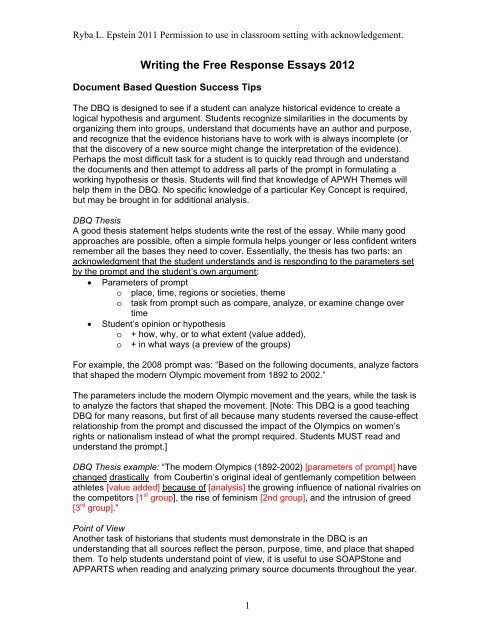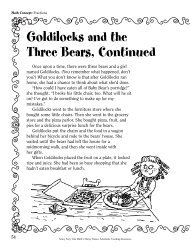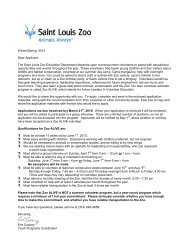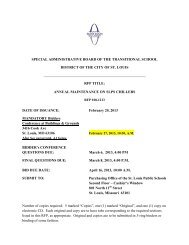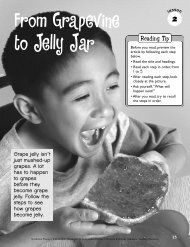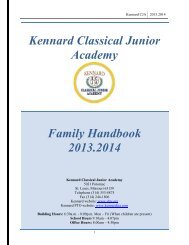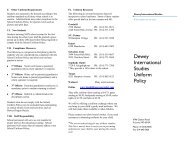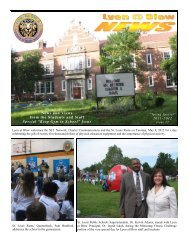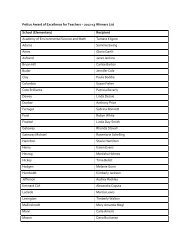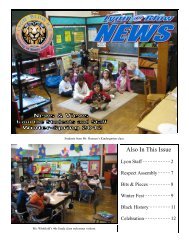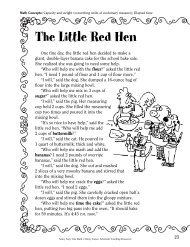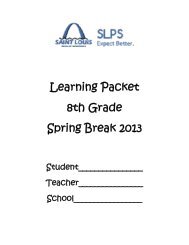2012 AP Essay Exam Success Tips
2012 AP Essay Exam Success Tips
2012 AP Essay Exam Success Tips
You also want an ePaper? Increase the reach of your titles
YUMPU automatically turns print PDFs into web optimized ePapers that Google loves.
Ryba L. Epstein 2011 Permission to use in classroom setting with acknowledgement.Writing the Free Response <strong>Essay</strong>s <strong>2012</strong>Document Based Question <strong>Success</strong> <strong>Tips</strong>The DBQ is designed to see if a student can analyze historical evidence to create alogical hypothesis and argument. Students recognize similarities in the documents byorganizing them into groups, understand that documents have an author and purpose,and recognize that the evidence historians have to work with is always incomplete (orthat the discovery of a new source might change the interpretation of the evidence).Perhaps the most difficult task for a student is to quickly read through and understandthe documents and then attempt to address all parts of the prompt in formulating aworking hypothesis or thesis. Students will find that knowledge of <strong>AP</strong>WH Themes willhelp them in the DBQ. No specific knowledge of a particular Key Concept is required,but may be brought in for additional analysis.DBQ ThesisA good thesis statement helps students write the rest of the essay. While many goodapproaches are possible, often a simple formula helps younger or less confident writersremember all the bases they need to cover. Essentially, the thesis has two parts: anacknowledgment that the student understands and is responding to the parameters setby the prompt and the student’s own argument:• Parameters of promptooplace, time, regions or societies, themetask from prompt such as compare, analyze, or examine change overtime• Student’s opinion or hypothesiso + how, why, or to what extent (value added),o + in what ways (a preview of the groups)For example, the 2008 prompt was: “Based on the following documents, analyze factorsthat shaped the modern Olympic movement from 1892 to 2002.”The parameters include the modern Olympic movement and the years, while the task isto analyze the factors that shaped the movement. [Note: This DBQ is a good teachingDBQ for many reasons, but first of all because many students reversed the cause-effectrelationship from the prompt and discussed the impact of the Olympics on women’srights or nationalism instead of what the prompt required. Students MUST read andunderstand the prompt.]DBQ Thesis example: “The modern Olympics (1892-2002) [parameters of prompt] havechanged drastically from Coubertin’s original ideal of gentlemanly competition betweenathletes [value added] because of [analysis] the growing influence of national rivalries onthe competitors [1 st group], the rise of feminism [2nd group], and the intrusion of greed[3 rd group].”Point of ViewAnother task of historians that students must demonstrate in the DBQ is anunderstanding that all sources reflect the person, purpose, time, and place that shapedthem. To help students understand point of view, it is useful to use SO<strong>AP</strong>Stone and<strong>AP</strong>PARTS when reading and analyzing primary source documents throughout the year.1
Ryba L. Epstein 2011 Permission to use in classroom setting with acknowledgement.Students learn to realize that documents reflect the points of view of the authors (shapedby such things as gender, nationality or ethnicity, occupation, class, religion, time andlocation), or that documents are of different types (such as legal codes, officialgovernment decrees, scholarly essays, or private journals) and are created for particularpurposes or audiences (sharing ideas with other scholars, propaganda to convince thepopulace, official government decrees, etc.) . Students should also learn to question thereliability or validity of a source by looking at the author, purpose, and intended audienceor by comparing it to other sources or their knowledge of world history. Point of View onthe <strong>AP</strong> exam usually involves the student’s discussion of either the author or the type ofsource.Point of View—Author• Long time <strong>AP</strong>WH teacher Ane Lintvedt asks students to consider “Why wouldthis person feel or think this way at this time, in this place?” Older or moresophisticated students may also look into the tone the author uses to try tounderstand his/her perspective.<strong>Exam</strong>ple: “Because she was a Buddhist, Trang hated to eat meat. Her attitude canbe seen in her use of ‘disgusting’ to describe the ‘happy’ meal.”Point of View—Document Type• What is the type of document?• For what purpose was it created?• Who is the intended audience?• What is the validity or reliability of the document?<strong>Exam</strong>ples: “Since this excerpt is from Pepys diary and was not intended for anyoneelse’s eyes, one can assume that it reflects his real opinion.”“Because this chart is from the WHO, which studies health factors around the world,we can assume that it is an accurate representation of infant mortality rates in SouthAmerica.”DBQ Additional DocumentHistorians never have all of the evidence: we are limited by those few sources we haveand must be ready to change our interpretation of the evidence if more sources arediscovered. In the DBQ, students are asked to recognize the limitations of the evidenceat hand and to explain how a different type of source might alter their interpretation.Logical places in the essay for a student to discuss the additional document areimmediately following the introduction (not as part of the thesis), in the conclusion, or ineach group of documents. Often the student looks for “whose voice is missing” from thesources.The good response:• Must be specific (can’t merely say “I’d like to hear from a peasant woman”);• Cannot overlap an existing source in the DBQ;• Must explain how this document might change or expand the interpretation of theavailable evidence and the prompt.2
Ryba L. Epstein 2011 Permission to use in classroom setting with acknowledgement.Additional Document <strong>Exam</strong>ple: “I’d be interested to see if the point of view of an Olympicathlete from a non-aligned nation shared the Cold War rivalry of the Soviet andAmerican athletes.”Change and Continuity over Time <strong>Success</strong> <strong>Tips</strong>The Change and Continuity over Time (CCOT) essay is designed to test the student’sawareness of cause-effect relationships and how global processes or events mightimpact a local region or culture. CCOT essays ask the student to explain the local impactof the forces for change—as well as what remains constant. The essay usually invites astudent to focus on one or more of the <strong>AP</strong>WH Key Concepts and Themes in a particularregion of the world. A good essay for the CCOT must:• restate the parameters of the prompt (the time period and location(s) in the thesisand stay within that time period for supporting material in the essay;• answer all parts of the question;• deal with both change and continuity;• use specific, relevant facts to support ideas (the facts must be from the timeperiod stated in the prompt);• analyze the reasons for specific changes/continuities (cause-effect analysis, notjust a list), especially how global processes or forces impact a particular region orculture;• use transitional words to clearly indicate change or continuity and cause-effect.The CCOT thesis may be one or more sentences in the introduction (or in theconclusion) of the essay. Usually options are provided in the prompt and students mustclearly identify which region/state/empire they are discussing. Just as with the DBQ, thethesis statement for the CCOT will not be used to score any other points, so studentsmust be certain to deal with all facets of the essay in the body of the essay as well asaddressing them in the thesis. For example, mentioning a global process or pattern inthe thesis alone will not earn that point and the thesis point; the student must discuss theprocess or pattern in the body of the essay. Since students must address both changesand continuities, it sometimes helps to refer to “the rule of three:” if a student addressestwo changes, they must also address at least one continuity (and vice versa). Of course,the student may discuss four or five changes and continuities, but a good rule of thumbis that a response that covers fewer than three will not adequately deal with the topic.CCOT Thesis: “During the period from ___ to ____ [must include the exact time periodfrom prompt] in _______ [location chosen from prompt], _______ changed little becauseof _____ [reason why remained same], but _______ [reason why changed] led to_____ changes.”CCOT Thesis <strong>Exam</strong>ple: “While social and gender roles remained relatively unchanged in19th century China because of enduring Confucian values, the intrusion of foreignpowers led to increasing problems for existing economic and political structures, andproducing widespread calls for reform or revolution.”3
Ryba L. Epstein 2011 Permission to use in classroom setting with acknowledgement.Comparison <strong>Essay</strong> <strong>Success</strong> <strong>Tips</strong>The Comparison and Contrast <strong>Essay</strong> (C/C) is designed to test the student’s ability torecognize that cultures in different places and/or times may be affected by commonphenomena and will react in similar or different ways based on the specialcircumstances of those cultures. The essay should be organized by theme or specificsimilarity/difference, not by listing everything the students knows about the first countryor culture and then everything about the second country our culture (sometimes called ageographical dump). Also, just as in the CCOT, the comparative question draws directlyfrom the <strong>AP</strong> Key Concepts and Themes. A good comparative essay must:• address both similarities and differences;• have thesis that identifies the major similarity and difference;• directly compare and contrast in the body of the essay—several times;• use specific supporting facts or examples for each similarity or differenceappropriate for the time and places of the prompt;• analyze the reasons for the similarities and differences discussed;• show the action of global processes or events on the specific region/culture beingdiscussed (agricultural revolution, Industrial Revolution, plague, Cold War, etc.)• use transitional words to clearly show similarities/differences.Just as for the DBQ and CCOT, the student’s response must take account of theparameters of the prompt and address all parts of the question, including recognizingboth similarities and differences.C/C Thesis Template: “During _____ [time period from prompt], _____ and _____[countries, regions, or cultures from prompt] responded to __________ [world process]similarly in ________, while there were differences in _________.”C/C Thesis <strong>Exam</strong>ple: “Anti-colonialism and independence movements [commonphenomenon or world process] were widespread during the decades following WorldWar II. Countries in both sub-Saharan Africa and South Asia obtained independencefrom European powers but there were key differences in the ways the new statesresolved political and economic challenges.”C/C Thesis <strong>Exam</strong>ple: “During the period from 1350 to 1650, the Black Death [commonphenomenon or world process] repeatedly swept through Afro-Eurasia. While boththe Middle East and Eastern Europe suffered great loss of life from the plague, thepolitical and socio-economic impact was far greater in Europe than in the Middle East.”4
Ryba L. Epstein 2011 Permission to use in classroom setting with acknowledgement.Signal or Transitional Words to use in <strong>AP</strong> <strong>Essay</strong>s<strong>Exam</strong>ples or supporting detail:For exampleIncludingFor instanceSuch as“Many men viewed women’s work as confined to the home. For example, John Jones(doc.4), a union worker from Manchester…”Comparison:Like, likewiseSimilarlyAlsoResemblingIn addition toJust asNot only… alsoBoth/neither“The Mughals imported military technology from the West. Similarly, the Ottomans alsoimported much of their military technology from France and Italy.”Contrast:ButAlthoughOn the other handInstead ofHowever,On the contraryWhileUnlike“While many countries in Latin America continued to export cash crops to Europe,Japan, on the other hand, chose to build their own industrial base by leap-froggingdevelopmental stages of industrialization.”Analysis/Cause-effect:BecauseSinceConsequentlyThereforeSoAs a result“Germany had to pay high reparations following WWI because the Allies wantedcompensation for their lost infrastructure and the lives of their soldiers and civilianpopulations.”5


